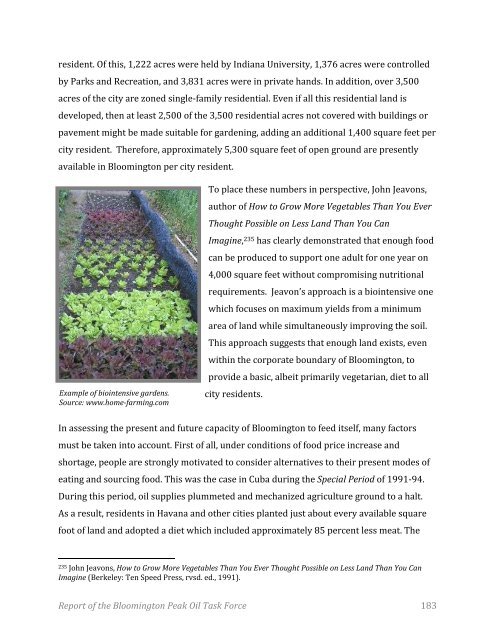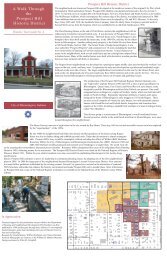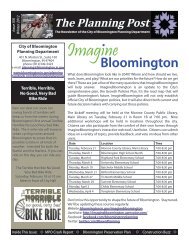Peak Oil Task Force Report - City of Bloomington - State of Indiana
Peak Oil Task Force Report - City of Bloomington - State of Indiana
Peak Oil Task Force Report - City of Bloomington - State of Indiana
You also want an ePaper? Increase the reach of your titles
YUMPU automatically turns print PDFs into web optimized ePapers that Google loves.
esident. Of this, 1,222 acres were held by <strong>Indiana</strong> University, 1,376 acres were controlled<br />
by Parks and Recreation, and 3,831 acres were in private hands. In addition, over 3,500<br />
acres <strong>of</strong> the city are zoned single‐family residential. Even if all this residential land is<br />
developed, then at least 2,500 <strong>of</strong> the 3,500 residential acres not covered with buildings or<br />
pavement might be made suitable for gardening, adding an additional 1,400 square feet per<br />
city resident. Therefore, approximately 5,300 square feet <strong>of</strong> open ground are presently<br />
available in <strong>Bloomington</strong> per city resident.<br />
Example <strong>of</strong> biointensive gardens.<br />
Source: www.homefarming.com<br />
To place these numbers in perspective, John Jeavons,<br />
author <strong>of</strong> How to Grow More Vegetables Than You Ever<br />
Thought Possible on Less Land Than You Can<br />
Imagine, 235 has clearly demonstrated that enough food<br />
can be produced to support one adult for one year on<br />
4,000 square feet without compromising nutritional<br />
requirements. Jeavon’s approach is a biointensive one<br />
which focuses on maximum yields from a minimum<br />
area <strong>of</strong> land while simultaneously improving the soil.<br />
This approach suggests that enough land exists, even<br />
within the corporate boundary <strong>of</strong> <strong>Bloomington</strong>, to<br />
provide a basic, albeit primarily vegetarian, diet to all<br />
city residents.<br />
In assessing the present and future capacity <strong>of</strong> <strong>Bloomington</strong> to feed itself, many factors<br />
must be taken into account. First <strong>of</strong> all, under conditions <strong>of</strong> food price increase and<br />
shortage, people are strongly motivated to consider alternatives to their present modes <strong>of</strong><br />
eating and sourcing food. This was the case in Cuba during the Special Period <strong>of</strong> 1991‐94.<br />
During this period, oil supplies plummeted and mechanized agriculture ground to a halt.<br />
As a result, residents in Havana and other cities planted just about every available square<br />
foot <strong>of</strong> land and adopted a diet which included approximately 85 percent less meat. The<br />
235 John Jeavons, How to Grow More Vegetables Than You Ever Thought Possible on Less Land Than You Can<br />
Imagine (Berkeley: Ten Speed Press, rvsd. ed., 1991).<br />
<strong>Report</strong> <strong>of</strong> the <strong>Bloomington</strong> <strong>Peak</strong> <strong>Oil</strong> <strong>Task</strong> <strong>Force</strong> 183









